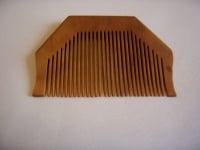Kanga
All Sikhs who have taken Amrit were commanded by Guru Gobind Singh at the Baisakhi Amrit Sanchar in 1699 to wear a small comb called a Kanga at all times. This was one of five articles of faith, collectively called Kakars that form the external visible symbols to clearly and outwardly display ones commitment and dedication to the order (Hukam) of the tenth master and become a member of Khalsa. The Khalsa is the Saint-Soldier of Guru Gobind Singh, who stated the following:
- He does not recognize anyone else except One Lord, not even the bestowal of charities, performance of merciful acts, austerities and restraint on pilgrim-stations; the perfect light of the Lord illuminates his heart, then consider him as the immaculate Khalsa."
- (Guru Gobind Singh in the Dasam Granth page 1350)
The Kanga is an article that allows the Sikh to care for his or her unshorn long hair, Kesh. The kanga is usually tucked in front of the "Rishi Knot" and tied under the turban to help in keeping the rishi knot firm and in place. It is to be used twice daily to comb and keep the hair in a disentangled and tidy condition. It represents the importance of discipline and cleanliness to the Sikh way of life and is used to keep the hair healthy, clean, shining and tangle-free.
The Rishis the ancient sages of the Hindu religion kept their hair tied in the top knot reminiscent of Mt. Meru, the mythical home of the Hindu Gods (also the style usually associated with Vishnu and sometimes with Shiva, who more often than not kept his hair in a tangled mess) and the central axis of Jambudipva.
Since many of the Hindu Rishis, or fakirs went about naked or nearly so with tangled and dirty hair, Guru Gobind Singh by the addition of the Kanga and the emphasis he placed on keeping ones hair clean and neat, and especially by the turban that is used to cover a Sikhs hair (Men and even some women) sought to differentiate his followers as separate and distinct (not part of) the Hindu religion.
The kanga is placed at the most highest place of the body, above the dasam duar. As it is made of wood it controls the electrical impulses running through the kesh and helps the wearer refrain from being angry.
External links
Where to buy a Kanga online
See also
| These articles deal with Sikh's Five ks |
|
Kesh (uncut hair) -|- Kara (bangle) -|- Kanga (small comb) -|- Kachera (under garment) -|- Kirpan (sword) |

